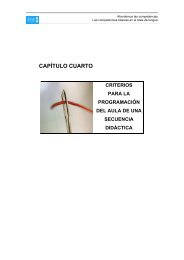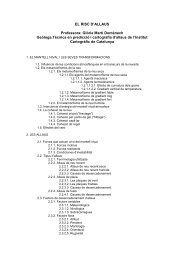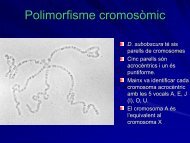Geological and environmental implications of the evaporite karst in Spain
Geological and environmental implications of the evaporite karst in Spain
Geological and environmental implications of the evaporite karst in Spain
Create successful ePaper yourself
Turn your PDF publications into a flip-book with our unique Google optimized e-Paper software.
Environ Geol (2008) 53:951–965 953<br />
Mar<strong>in</strong>e Mesozoic <strong>and</strong> Tertiary evaporitic formations<br />
The most widespread episodes <strong>of</strong> evaporitic sedimentation<br />
took place dur<strong>in</strong>g Triassic <strong>and</strong> lower Liassic times <strong>in</strong><br />
shallow-mar<strong>in</strong>e platform environments (lagoons, sabkhas)<br />
affected by a rift<strong>in</strong>g process (Ortí et al. 1996). Triassic<br />
<strong>evaporite</strong>s are made up <strong>of</strong> Ca-sulfate <strong>and</strong> halite units up to<br />
400 m thick embedded <strong>in</strong> variegated marls <strong>and</strong> shales. This<br />
formation occurs <strong>in</strong> numerous outcrops dispersed over <strong>the</strong><br />
Alp<strong>in</strong>e orogens, locally form<strong>in</strong>g diapiric structures (Fig. 1).<br />
The lower Liassic <strong>evaporite</strong>s (anhydrite zone), up to 800 m<br />
thick, are composed <strong>of</strong> Ca-sulfates associated with dolomites<br />
(Pérez-López et al. 1996). Borehole data reveal <strong>the</strong><br />
presence <strong>of</strong> several Jurassic <strong>and</strong> Upper Cretaceous anhydritic<br />
units more than 100 m thick <strong>in</strong> some sectors <strong>of</strong> <strong>the</strong><br />
Iberian Pen<strong>in</strong>sula. In <strong>the</strong> Iberian Range <strong>and</strong> <strong>in</strong> <strong>the</strong> Pyrenees<br />
<strong>the</strong>re are also gysiferous units deposited <strong>in</strong> transitional <strong>and</strong><br />
probably cont<strong>in</strong>ental environments with a poorly constra<strong>in</strong>ed<br />
late Cretaceous-Paleocene age (Garum facies).<br />
Jurassic <strong>and</strong> Cretaceous Ca-sulfate units, with a limited<br />
outcrop extent, are frequently represented close to, <strong>and</strong> at,<br />
<strong>the</strong> ground surface by collapse breccias generated by <strong>in</strong>terstratal<br />
<strong>karst</strong>ification <strong>of</strong> <strong>the</strong> <strong>evaporite</strong>s <strong>and</strong> brecciation <strong>of</strong><br />
<strong>the</strong> associated carbonate rocks, form<strong>in</strong>g <strong>the</strong> so-called carniolas<br />
(Gutiérrez et al. 2001).<br />
Dur<strong>in</strong>g <strong>the</strong> Paleogene, mar<strong>in</strong>e evaporitic sedimentation<br />
was restricted to <strong>the</strong> sou<strong>the</strong>rn foredeep <strong>of</strong> <strong>the</strong> Pyrenees,<br />
where <strong>evaporite</strong> deposition took place dur<strong>in</strong>g two regressive<br />
phases: <strong>the</strong> Middle Eocene phase (Lutetian), <strong>and</strong> <strong>the</strong><br />
Upper Eocene phase (Priabonian). Evaporite deposition <strong>of</strong><br />
<strong>the</strong> first phase, conf<strong>in</strong>ed to <strong>the</strong> eastern sector, is represented<br />
by <strong>the</strong> Beuda Gypsum, composed <strong>of</strong> 100 m <strong>of</strong> anhydrite/<br />
gypsum <strong>and</strong> m<strong>in</strong>or halite deposits at depth (Ortí <strong>and</strong> Rosell<br />
1997). The second phase developed <strong>in</strong> two sub bas<strong>in</strong>s,<br />
probably l<strong>in</strong>ked <strong>in</strong> <strong>the</strong> <strong>in</strong>itial stage to form a s<strong>in</strong>gle sedimentary<br />
trough, 300 km long, called <strong>the</strong> South Pyrenean<br />
Potash Bas<strong>in</strong>. These sediments are composed <strong>of</strong> Ca-sulfate<br />
<strong>and</strong> halite with a substantial amount <strong>of</strong> K-Mg chlorides,<br />
ma<strong>in</strong>ly sylvite <strong>and</strong> carnallite. The Cardona Sal<strong>in</strong>e Formation<br />
(eastern subbas<strong>in</strong>), with 300 m <strong>of</strong> chlorides, rema<strong>in</strong>s <strong>in</strong><br />
<strong>the</strong> autochthonous zone <strong>of</strong> <strong>the</strong> Ebro Bas<strong>in</strong>, whereas <strong>the</strong><br />
Guendula<strong>in</strong> Formation (western subbas<strong>in</strong>), up to 100 m<br />
thick, has been <strong>in</strong>corporated <strong>in</strong>to <strong>the</strong> allochthonous structural<br />
units <strong>of</strong> <strong>the</strong> Pyrenees (Rosell <strong>and</strong> Pueyo 1997).<br />
Neogene mar<strong>in</strong>e formations occur <strong>in</strong> <strong>the</strong> Penedés Bas<strong>in</strong><br />
(Catalan Coastal Range) <strong>and</strong> <strong>in</strong> a large number <strong>of</strong><br />
<strong>in</strong>tramontane bas<strong>in</strong>s <strong>of</strong> <strong>the</strong> eastern sector <strong>of</strong> <strong>the</strong> Betic<br />
Cordillera. The <strong>in</strong>ternal bas<strong>in</strong>s <strong>of</strong> <strong>the</strong> Betic Cordillera<br />
(Lorca, Fortuna, Guadalentín, Granada) host Tortonianearly<br />
Mess<strong>in</strong>ian evaporitic sequences up to several hundred<br />
meters thick made up <strong>of</strong> Ca-sulfate <strong>and</strong> halite that record a<br />
transition from mar<strong>in</strong>e to cont<strong>in</strong>ental conditions (Playà<br />
et al. 2000). In <strong>the</strong> external bas<strong>in</strong>s <strong>of</strong> <strong>the</strong> Betic Cordillera<br />
(Sorbas, Almería, Nijar-Carboneras, San Miguel de Sal<strong>in</strong>as,<br />
Palma de Mallorca), <strong>the</strong> mar<strong>in</strong>e <strong>evaporite</strong>s, Upper<br />
Mess<strong>in</strong>ian <strong>in</strong> age, are composed <strong>of</strong> 12–14 cyclic layers <strong>of</strong><br />
primary selenitic gypsum with a total thickness <strong>of</strong> 70–<br />
130 m (Rosell et al. 1998).<br />
Cont<strong>in</strong>ental Tertiary evaporitic formations<br />
Most <strong>of</strong> <strong>the</strong> ma<strong>in</strong> Spanish Tertiary bas<strong>in</strong>s conta<strong>in</strong> extensive<br />
<strong>and</strong> thick cont<strong>in</strong>ental evaporitic formations. The Ebro Bas<strong>in</strong>,<br />
subsequent to <strong>the</strong> Priabonian potassic phase, evolved<br />
<strong>in</strong>to an endorheic condition giv<strong>in</strong>g way to <strong>the</strong> deposition <strong>of</strong><br />
extensive Ca-sulfate <strong>and</strong> halite lacustr<strong>in</strong>e evaporitic formations<br />
<strong>of</strong> Upper Eocene-early Oligocene age. These are<br />
<strong>the</strong> Barbastro Gypsum <strong>and</strong> <strong>the</strong> Puente de la Re<strong>in</strong>a Gypsum,<br />
located <strong>in</strong> <strong>the</strong> central-eastern <strong>and</strong> <strong>the</strong> western sectors <strong>of</strong> <strong>the</strong><br />
bas<strong>in</strong>, respectively. They reach 300–400 m <strong>in</strong> thickness<br />
<strong>and</strong> crop out <strong>in</strong> <strong>the</strong> core <strong>of</strong> several salt anticl<strong>in</strong>es (Salvany<br />
1997). From <strong>the</strong> Middle Oligocene to <strong>the</strong> early Miocene,<br />
two thick evaporitic formations were deposited <strong>in</strong> <strong>the</strong><br />
western sector <strong>of</strong> <strong>the</strong> Ebro Bas<strong>in</strong>, <strong>the</strong> Falces <strong>and</strong> <strong>the</strong> Lerín<br />
Formations. The tightly folded Falces Formation reaches<br />
more than 1,000 m thick <strong>in</strong> <strong>the</strong> core <strong>of</strong> diapiric anticl<strong>in</strong>es<br />
<strong>and</strong> is made up <strong>of</strong> Ca-sulfate, glauberite, <strong>and</strong> halite. The<br />
Lerín Formation, 500–1,000 m <strong>in</strong> thickness, is made up <strong>of</strong><br />
Ca-sulfate, glauberite, halite, <strong>and</strong> polyhalite (Salvany<br />
1997). At <strong>the</strong> beg<strong>in</strong>n<strong>in</strong>g <strong>of</strong> <strong>the</strong> Miocene, <strong>the</strong> bas<strong>in</strong> depocenter<br />
shifted to <strong>the</strong> central sector <strong>of</strong> <strong>the</strong> Ebro Bas<strong>in</strong>, where<br />
<strong>the</strong> Zaragoza Formation (upper Oligocene?-lower Miocene)<br />
was deposited. This formation, 800 m thick, crops<br />
out around Zaragoza city <strong>and</strong> <strong>in</strong>cludes, close to <strong>the</strong> surface,<br />
halite <strong>and</strong> glauberite units more than 150 <strong>and</strong> 30 m thick,<br />
respectively (Salvany et al. 2007). The youngest evaporitic<br />
unit corresponds to <strong>the</strong> Cerezo Gypsum (Upper Miocene),<br />
located <strong>in</strong> <strong>the</strong> Bureba corridor, which l<strong>in</strong>ks <strong>the</strong> Ebro <strong>and</strong><br />
<strong>the</strong> Duero bas<strong>in</strong>s. This unit, about 200 m thick, bears Casulfates<br />
<strong>and</strong> glauberite (Anadón 1990). In addition to <strong>the</strong>se<br />
formations deposited <strong>in</strong> central high-sal<strong>in</strong>ity lakes, <strong>the</strong><br />
Ebro Bas<strong>in</strong> fill also conta<strong>in</strong>s several m<strong>in</strong>or gypsum units<br />
deposited <strong>in</strong> marg<strong>in</strong>al lakes, like <strong>the</strong> Paleogene <strong>evaporite</strong>s<br />
associated to <strong>the</strong> Catalan Coastal Range <strong>and</strong> <strong>the</strong> Oligo-<br />
Miocene units located along <strong>the</strong> Iberian marg<strong>in</strong> <strong>of</strong> <strong>the</strong> bas<strong>in</strong><br />
(Ortí 1997).<br />
Evaporite sedimentation <strong>in</strong> <strong>the</strong> Tertiary Duero Bas<strong>in</strong> is<br />
recorded by a few Middle–Upper Miocene gypsum units<br />
less than 100 m thick with a significant proportion <strong>of</strong><br />
<strong>in</strong>soluble sediments (Mediavilla et al. 1996). The Tertiary<br />
Tajo Bas<strong>in</strong> is composed <strong>of</strong> two subbas<strong>in</strong>s: <strong>the</strong> western<br />
sector or <strong>the</strong> Madrid Bas<strong>in</strong>, <strong>and</strong> <strong>the</strong> eastern sector or <strong>the</strong><br />
Loranca Bas<strong>in</strong>. Dur<strong>in</strong>g <strong>the</strong> Paleogene, <strong>evaporite</strong> deposition<br />
was restricted to <strong>the</strong> Madrid Bas<strong>in</strong>, represented by folded<br />
Ca-sulfate units. This bas<strong>in</strong> also conta<strong>in</strong>s an extensive<br />
Miocene evaporitic succession constituted by two units: <strong>the</strong><br />
123





